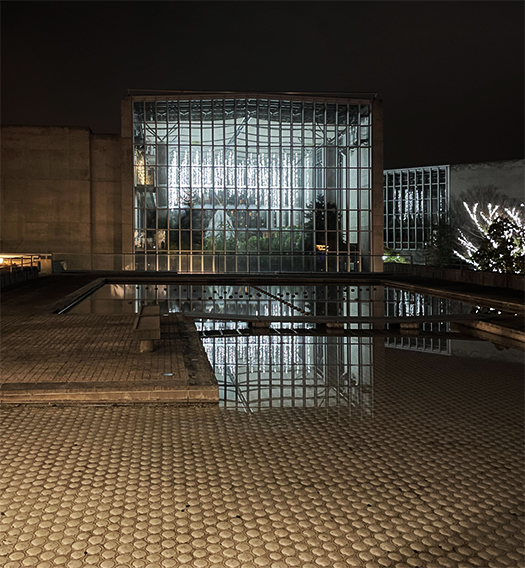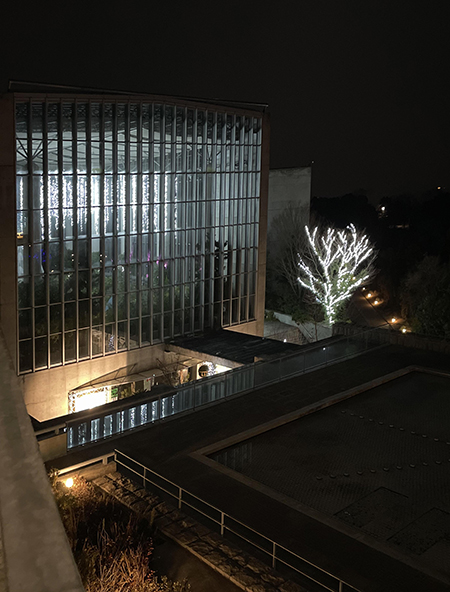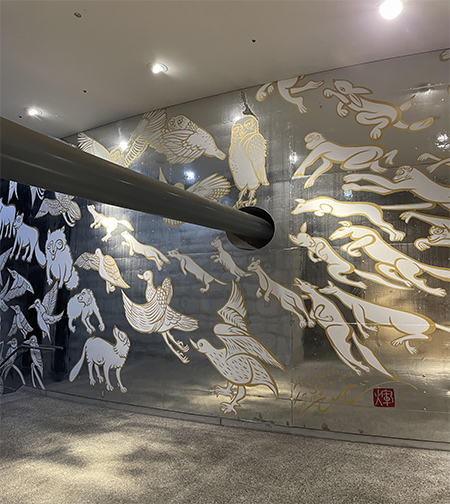
淡路夢舞台の夜景の白眉のような存在がガラスの表皮を持つ温室。その前庭的な水庭はその外観を反射させて宝石のようなきらめきを感じさせている。また昨日ご紹介の水底を覆うホタテ貝のささやくようなシルエットに対して、繊細な外観を浮かび上がらせている。内部の植物群が睡眠中のイキモノのような生命感の陰影をほの暗く見せてくれている。寝ているけれどなんとなくいのちの「ゆらぎ」を感じさせてくれる。
周囲は人工的な自然復元を目指した緑地公園だけれど、まるで街中のイルミネーションのような世界が対比的に出現している。そういう環境のなかのコントラストとして有機的存在感。
照明というものは基本的に内部の「用」に準拠した計画になるものだろうけれど、この夜景外観を見ると、むしろこのような視覚臨場体験をメインの建築機能性として計画したのではないだろうかと思わせる。
北海道が官学民を挙げて取り組んできた断熱や気密性という建築の領域はいわば「顕教」の部分であって、安藤建築はそれに対して「密教」的な志向性を持っているのかもしれない。やはり高野山を持つ関西の地域文化性ということなのか、みたいな夜想に思わず没入する瞬間。ホタテ貝殻の諸行無常感・・・。
これは体験からの印象という段階なんだけれど、安藤忠雄さんの建築志向性、そしてそれを深く支持する関西圏の風土性文化の基底にはそういう「雰囲気」の歴史伝統があるように思えるのですね。わたしは密教の真言宗徒なのである意味、カラダで受容する部分をもっている。
ひょっとすると空海の目指した「高野山」世界というのは、日本人に密教的な世界観を形象化した建築群だったのかもしれない。急峻な山道をようやく通り抜けて山上の平坦地形と寺院建築群が出現する高野山は、密教的「建築」体験として日本人に深く刷り込まれているのかも。



今回は温室の眠っている時間しか対面しなかったので内部の様子、とくに45度軸線がずれて交叉している温室内部の様子は体験できなかった。この温室のさらに奥の野外劇場とともに次回に参観してみたい。
English version⬇
Esoteric nightscape, greenhouse interacting with water garden scallops Awaji Yumebutai-7
Tadao Ando’s architecture and Kukai’s Koyasan Buddhist buildings. I feel that their orientations are similar. This is just an impression stage from my experience. …
The greenhouse with a glass surface skin is the white-hot jewel of the nightscape of Awaji Yumebutai. Its front garden-like water garden reflects the appearance of the greenhouse, giving it a sparkling appearance like a jewel. It also reveals a delicate appearance in contrast to the whispering silhouette of the scallop shells that cover the bottom of the water, introduced yesterday. The plants inside the sculpture give us a darker shadow of a sense of life, like a sleeping creature. Although they are sleeping, we can somehow feel the “flickering” of life.
The surrounding area is a green park that aims to artificially restore nature, but it is contrasted by a world that looks like a city illumination. The organic presence of the lighting contrasts with this environment.
Although lighting is basically planned in accordance with the “use” of the interior, this nightscape exterior makes us believe that the main architectural functionality of the building was to provide such a visually realistic experience.
The architectural fields of thermal insulation and airtightness that Hokkaido’s government, academia, and civilian sectors have been working on are, so to speak, the “manifestation” side of architecture, while Ando’s architecture may have an “esoteric” orientation. I was immersed in a moment of contemplation, wondering if this is a regional cultural characteristic of the Kansai region, which is home to Koyasan. The sense of impermanence of scallop shells….
This is just an impression from my experience, but it seems to me that there is a historical tradition of such “atmosphere” at the base of Tadao Ando’s architectural orientation and the Kansai region’s endemic culture that deeply supports it. I am a Shingon Buddhist of esoteric Buddhism, so in a sense, I have a part of my body that accepts this kind of atmosphere.
Perhaps Kukai’s goal of “Koyasan” was a group of buildings that embodied the esoteric worldview of the Japanese people. Koyasan, where the flat terrain on the mountain and the temple buildings emerge after finally passing through the steep mountain path, may have been deeply imprinted on the Japanese people as an esoteric “architectural” experience.
house. I would like to visit the greenhouse and the open-air theater at the far end of the greenhouse next time.
Posted on 3月 4th, 2023 by 三木 奎吾
Filed under: 日本社会・文化研究







コメントを投稿
「※誹謗中傷や、悪意のある書き込み、営利目的などのコメントを防ぐために、投稿された全てのコメントは一時的に保留されますのでご了承ください。」
You must be logged in to post a comment.